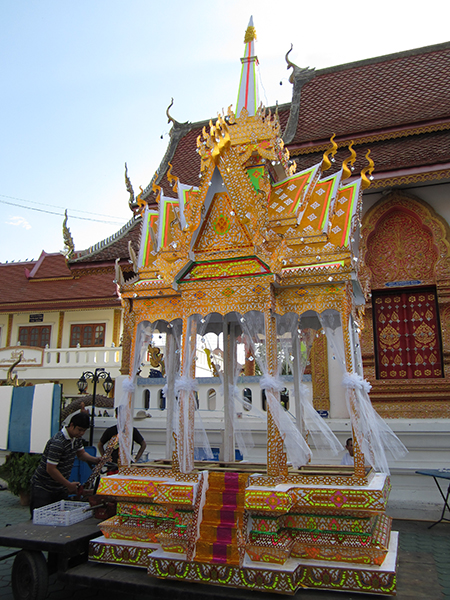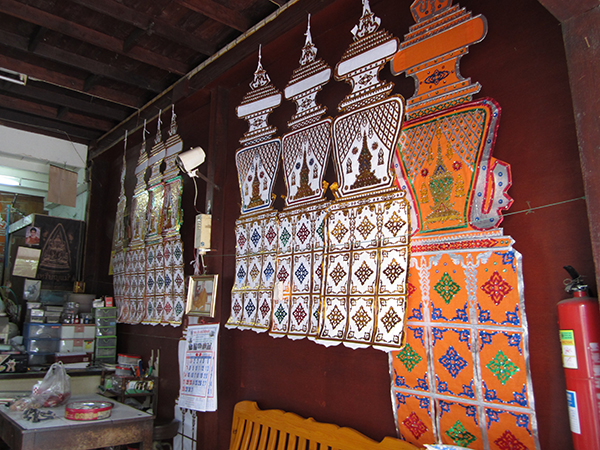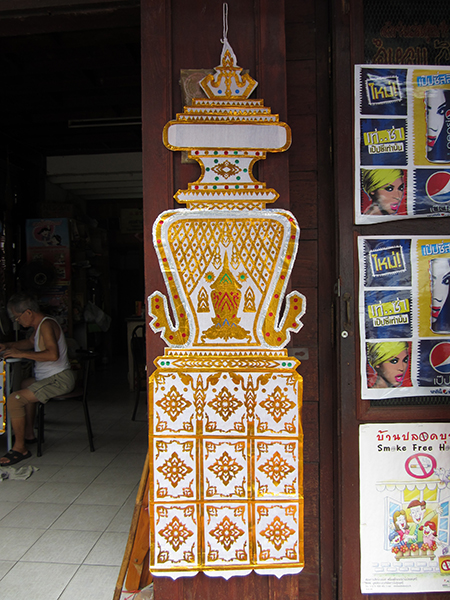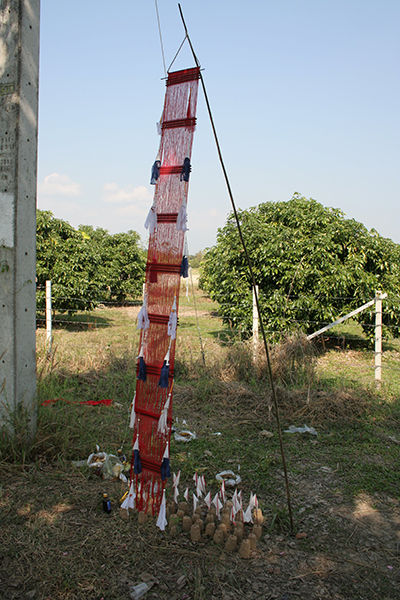- Volume 46 | Permalink
- Print article
- Download PDF 780kb
Abstract
Buddhist rituals and ceremonies in contemporary Northern Thailand are performed as a way to frame and manage the uncertainty and inevitability of death. In the first glimpses of a Northern Thai funeral ceremony, it is easy to conclude that the most important participants are the monks, the lay specialist, and the dead person’s family, but a closer look will reveal the presence of a three-tail banner hanging at the feet of the deceased. Through its physical presence in the ceremony and its movement with the body from monastery to cremation ground, this funeral banner simultaneously serves as the embodiment of Buddhist principles, as a reminder that all living things will one day die, and as a vision of heavenly rebirth. By giving form to the immaterial, Buddhist funerary banners offer a visual and material experience as they embody the process of death and rebirth. In this essay, I examine the multivalent aspects of funerary banners, in particular their transformative and performative role in the funeral ceremony.
Introduction: Transition
I observed in four funerals in Chiang Mai, Mae Rim, and San Pa Tong in Chiang Mai province between 2012 and 2015. Based on those experiences, I generated the following composite description of the final rituals in Northern Thai funerals.
The monks complete their chants and sermons, but the flurry of activity outside begins even before the chants end. The undertaker, with the assistance of several other men, takes the floral ornament and other objects away from the coffin. As they do this, they stop to pay respects to the deceased. The coffin is already resting in the brightly colored cremation structure, which, in turn, sits atop a carriage on wheels. The men unwind a long rope in front of the structure and attach it to the carriage. They then wheel a framed photograph of the deceased in front of the long cord. Finally, the undertaker takes a white banner with three tails that had been hanging conspicuously on a bamboo stick next to the coffin and clutches it over his shoulder. He places a white bag over his other shoulder and carries a coconut in his hand. He stands perhaps thirty yards away from the coffin and waits (fig. 1).
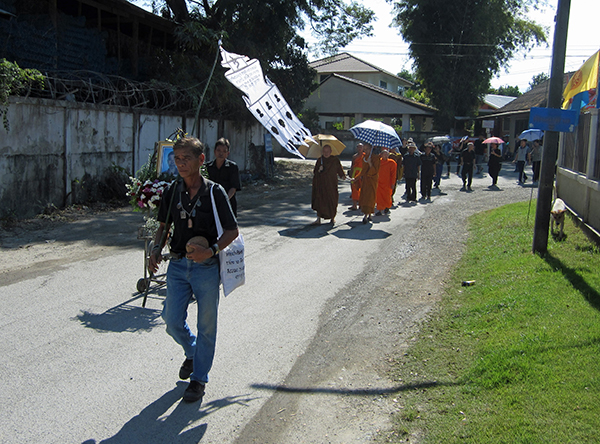
Once the monks and funeral attendees have had a chance to stand and stretch their legs, they quickly take their places in line behind the undertaker, who continues to hold the banner. Following the undertaker is a man pushing the contraption that holds the photograph of the deceased. Family members and close friends grab hold of the long rope attached to the carriage, and the monks take the white cotton cord into their hands. Additional funeral attendees follow along behind the carriage. Prerecorded funeral music soon plays from a pickup truck fitted with large speakers, and the procession begins to move slowly toward the cremation ground.
A funeral procession makes its way down a busy road in Chiang Mai. Its final destination is the cremation ground. Chiang Mai, Thailand, February 2016. Video by R. Hall.
The mood is solemn as the procession goes along its way. The undertaker stays in the lead, still carrying the banner, bag, and coconut. The carriage with the cremation structure and coffin is moved entirely through the pulling of the rope. Special care is taken to ensure that the carriage stays on track and does not get tangled with anything in its path. Music continues to play. The music, banner, and cremation structure inform anyone watching that a funeral is passing by, and no one gets in its way.
After the procession reaches the cremation ground, the coffin and structure are set up with flowers and other accoutrements. A series of final rituals is performed, the cloth banner and the cloth bag are placed in the coffin, and the structure is set on fire, left to burn until only ashes remain. As attendees leave the cremation ground, they sprinkle themselves with floral-scented water, a way to cleanse themselves and ensure that no remnants of the dead remain with them as they return to their regular lives.
The Banners’ Form and Meaning
Often overlooked by scholars because of their ephemeral nature, textile and paper arts in fact play a central role in the most crucial ritual moments of Northern Thai Buddhism.[1] Such is the case in the time following death, when a single white banner with three tails hangs near the body of the deceased as it rests in its coffin, receiving chants and blessings from monks as part of the funeral and preparation for the eventual cremation. The same banner later guides the funeral procession as it makes its way to the cremation grounds after the funeral ceremony. Because these banners are never seen or used outside of the funerary context, their physical presence maintains an explicit connection to their performative role within the funeral. The banners are inseparable from their ritual context, both physically and in the minds of the Northern Thai people familiar with this art form. In other words, the true purpose of the banner is enacted only when a death occurs and the funeral takes place, which further conflates the connection between art object and ritual function.
The value of this ephemeral work of art is specific to the social and cultural context of the Northern Thai funeral, the only place where these banners are made and used. Outside of the region and detached from such a significant ceremony, they lose their potent meaning. Funeral banners’ stylistic and decorative details are not as important as the adherence to the three-tail form and their enduring presence at funeral ceremonies.[2] Because these banners are integral to the funeral but have a relatively abstract form, residents of Northern Thailand appear to have multiple interpretations of their meaning and purpose, as revealed in interviews and in Thai-language publications on the subject, almost as if the banners are a blank slate reflecting the beliefs of the person doing the explaining.
Each explanation for the banners further solidifies their integration in the funeral ceremonies. Relatively simple in appearance, these single pieces of cut cloth or mulberry paper might be easy to overlook in the context of the overall funeral. Yet the banner embodies many of the elements that are most essential to a funeral ceremony: impermanence, protection, transition, and the goal of heavenly rebirth. Through the banners’ production, their physical form, and their perceived connection to the spirit of the dead, these art objects are transformative and serve to remind funeral attendees and passersby of the importance of a properly executed funeral ceremony for ensuring the safe passage of the spirit of the deceased toward a new life.
The funeral banners discussed here are called tung sam hang, which means “three-tail banner,” a name that relates to their overall shape—a bulbous body and three long tails hanging down (fig. 2). Understanding the form of the banners, discussed in detail below, provides insight into interpretations of their symbolic meaning and possible reasons for the specificity of their shape, but there is more to the banners than meets the eye. They have a dual function of serving both the living and the dead, and this is of utmost importance in understanding their presence at Northern Thai funerals. Throughout the funeral and during the procession to the cremation ground, the banners are equally relevant to the living and the dead, but they are specifically useful to the deceased following cremation.
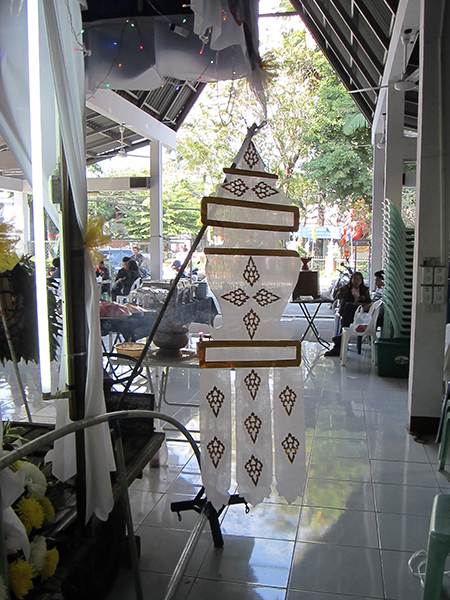
Besides giving the banners their name, the form is of great meaning because it is one of the only things about the banners that does not change, making them instantly recognizable. Whether the three-tail banner is white, used in the funeral of laity, or saffron, signifying the funeral of a monk, it always has three tails, without exception. Those three tails hang from the banner’s body, the only formal aspects that are never altered. Explanations for the three tails vary; their meaning is open to interpretation but inevitably relates to the tenets of Buddhism. Despite their differences, all of the explanations are connected to the lessons emphasized in the funeral ceremony and the intentions of the living in performing a funeral for the deceased.
Several groupings of three are foundational in Buddhism. Monks and laity in Northern Thailand use these groups in their interpretations of the banner’s tails. Certain publications—including several Thai-language books with descriptions of three-tail banners, Konrad Kingshill’s mid-twentieth-century ethnography of Ku Daeng, and Charles Keyes’s work on Northern Thai funerals—equate the tails with the Triple Gem of Buddhism: the Buddha, the dhamma (teachings), and the sangha (community of monks).[3] I also have been told about this symbolism in interviews conducted in and around the city of Chiang Mai.[4] In this interpretation, the banner reminds funeral attendees of the importance in taking refuge in the Triple Gem.[5] Looking further into this association, we find that the tails then serve a specific function for the deceased because Northern Thai Buddhists believe the dead take refuge in the Triple Gem as they travel in the cycle of death and rebirth. As Buddhists in both life and in death, they receive much-needed assistance from this refuge as they navigate the uncertain journey that takes place after death.
An equally compelling explanation arose in interviews I conducted with monks at three monasteries around Chiang Mai in 2013.[6] Each monk I spoke with explained that the three tails most certainly corresponded to the three characteristics of existence in Buddhism: anicca (impermanence), dukkha (suffering), and anatta (absence of self). The abbot of Wat Koh Klang in Chiang Mai explained this interpretation of the three tails as a reflection of the facts everyone encounters throughout life. The three characteristics are often part of the funeral ceremony in Northern Thailand, and even if just anicca is spoken by monks in the ceremony, the other two usually are implied because of their specific relationship within Buddhist belief.[7]
Both of these explanations connect the banner’s tails to overt Buddhist themes that are utilized in nearly any Buddhist ceremony, but particularly funerals. In other words, the differences in the interpretations of the three-tail banner are of less importance than what they share: a connection to the key Buddhist concepts central to any funeral that serve both to assist the dead and to inspire the living.
The Northern Thai Buddhist Funeral
Funerals are vital to Northern Thai Buddhist practice.[8] The inevitability of death is an inherent part of Buddhist belief as a whole, and many of the merit-making activities that are integrated into local rituals relate to keeping deceased family members safe. For the living, the funeral ceremony is simultaneously an opportunity to support the sangha and to say good-bye to the deceased. Family and friends want to feel reassured that all the proper measures were taken to ensure that the transition was successful and that the deceased is not doomed to linger on Earth as a ghost or in one of the many levels of hell that exist within Buddhist cosmology. In many ways, a funeral might mark the end of a life, but it is also viewed as the beginning of a new life or the transformation into a new form in a new realm of existence.[9] Objects and actions that are part of the funeral ritual echo these meanings, with the three-tail banner providing perhaps the closest link between the deceased and the living.
The delicate nature of the period of time following a death cannot be overstated. It is a liminal moment in which the status of the deceased is rather ambiguous. Improper treatment of the dead inevitably creates an unwelcome outcome. Because of the belief in Northern Thailand (and the region as a whole) that a spirit can get lost, stay within the area, and wreak havoc on the living, death is seen as both dangerous and worrisome to the larger community. As a result, many of the rituals that comprise a funeral are dedicated to helping the soul move away from the living and toward a new realm, potentially heaven. Any number of actions by the living can be part of this process. Among the most common is making merit by giving donations to the monastery and transferring that merit to the dead. An equally crucial act is finding a physical way to guide the spirit of the deceased from one realm of existence to the next. The three-tail banner is one such guide and arguably the most important.
A Northern Thai funeral typically lasts three to seven days.[10] The length of time is related to the age and status of the deceased and variations in local traditions. During that time, the corpse is cared for and closely watched over. Relatives, friends, and neighbors join together to pay respects to the deceased, and monks visit daily to chant parts of the Abhidhamma and give sermons about impermanence, living a life full of merit, and the goals of attaining nibbana.[11] The culmination of a funeral is the cremation, when the corpse is burned in a final release from corporeal attachment in this life and an emphatic concluding reminder of impermanence.
Monks conduct the funeral ceremonies with the assistance of the local community. The chants and sermons delivered by monks encourage living attendees to contemplate the nature of existence, focus on the importance of living a wholesome life, and ease concerns about the transition from one life to the next. The Northern Thai Buddhist community also believes that monks’ chants and sermons ensure safety for the dead, guiding them through the tenuous period of time after death into a more peaceful existence. Monks also remind the living of the importance of making merit for the dead to continue to improve their chances of going to and staying in heaven. In Buddhist Northern Thailand, a funeral is not complete without the monks’ participation.
Monks are also the focus of one of the most important rituals during a funeral, which takes place immediately before cremation: the offering of robes from the family of the deceased or high-ranking guests to the monks who presided over the ceremony. This ceremony, called bangsakun in Thai (pamsakula in Pali), recalls the earliest forms of Buddhist monasticism, in which the robes worn by monks were constructed from rags retrieved from cemeteries. These rag robes symbolized the monks’ understanding of death as part of life and the unique ability of monks to be unaffected or untouched by death and, by extension, lingering spirits.[12] In contemporary funeral rituals, it serves as another opportunity for family to make merit on behalf of the deceased.
The laypeople who attend the funerals are also important to the success of the ritual. Family, friends, and neighbors come together to perform any variety of functions. This includes looking after the monks and other guests. Perhaps most important, family and friends offer food, money, and other gifts to the monks, thus making merit on behalf of the deceased. In addition, the family of the deceased is responsible for feeding funeral attendees, supplying large meals as another merit-making opportunity. Funeral attendees also help to create a lively, sometimes boisterous environment as the funeral progresses—to scare off ghosts and display community unity at a time of uncertainty.[13]
The three-tail banner is one piece of a larger overall assemblage (fig. 3). Northern Thai funerals offer a rich array of ephemeral works of art, large and small, that surround the body of the deceased. These objects provide assistance for the dead and comfort for the living while their temporary existence echoes the frailty of life in general. Other pieces that complete the array of funeral arts include a white cloth bag that holds food specifically chosen to accompany the deceased and help them to successfully survive their journey from one life to the next. Throughout the funeral, the bag is placed by the coffin near the three-tail banner; the two objects are believed to complement each other in that both are essential to a successful transition to heaven.
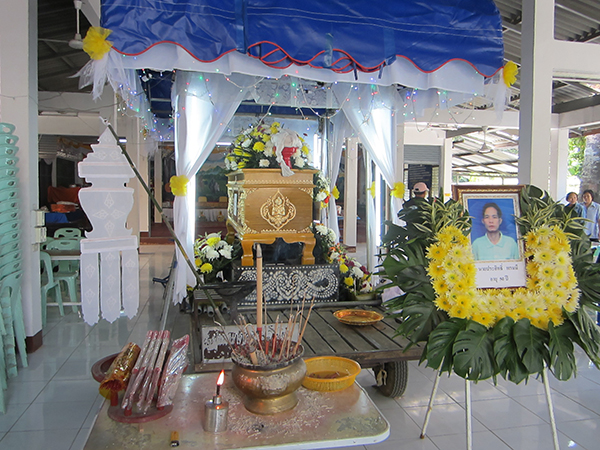
Perhaps the most visually commanding object in a Northern Thai funeral is the large wood and paper cremation structure that houses the corpse at the end of the funeral festivities, in its procession to the cremation ground, and is burned with the deceased in the cremation fire (fig. 4). It often takes the form of a brightly colored, pinnacled architectural structure called a prasat sop (funeral palace) or a smaller house-like structure called a lang klai, which is quite similar to the prasat sop but with a simple roof and no pinnacle.[14] A person’s status and wealth affects the size, style, and color of the structure used for his cremation, though in the past these divisions were more strictly adhered to than in the present.[15] In fact, of all the visual components of a Northern Thai funeral, the prasat sop is perhaps the most endangered, as it is increasingly being replaced by cremation ovens housed in permanent concrete structures—a tradition adopted from the Bangkok region.
The coffin is made out of wood. Images of golden thewada (heavenly beings) adorn its sides. The coffin is central to funeral activities because it holds the corpse and is literally connected to the monks and a Buddha image through white cotton string.[16] Visually the coffin is also a focal point because many of the smaller objects that are part of the funeral rest on or near it throughout the ceremony. These include small metal banners called tung lek tung thong (iron and gold banners) hanging on a wooden or metal armature, bouquets of flowers, a coconut, a monk’s bowl, white cotton string, incense, candles, a photo of the deceased, small sa tuang (banana leaf trays), the white bag, and the three-tail banner. Each object has a purpose, from honoring the deceased to guiding the spirit to heaven. Other objects that are integral to the funeral ceremony include a terra-cotta pot containing charcoal, usually carried in the cremation procession, and sandalwood flowers that are offered to the deceased moments before the cremation fire is lit; in the past, paper animals representing the zodiac were part of the final cremation display.[17]
Most of these funerary objects are made in the days following death. They are purchased or commissioned either by family or members of the community and are made by local specialists. At a typical cremation, most of these objects are burned in the fire together with the body. Such destruction in the cremation fire is a reminder of impermanence but also, as is the case with the three-tail banner, a means of ensuring family and friends that those objects will travel with and guide the deceased in the afterlife.
Making the Three-tail Banner
Because the singular purpose of three-tail banners is display during a funeral, they are usually purchased or made to order following a death. Family members have several options for obtaining a three-tail banner. They can go to a market or shop that sells Buddhist ritual objects and purchase a banner as well as other important funeral objects. Another option is to obtain the banner from the builders of the cremation structure. A third option is to commission a local villager to make a banner, often an expert who has previously made three-tail banners. Most important, the banner maker must be a male who, at some point in his life, was ordained as a monk or a novice monk.[18] He then writes the name, birth day, and death day of the deceased on the banner, though this is not necessarily requisite for it to have potency.
A specific procedure for making the banner must be followed as well. It must be cut into its shape in proper order, from the head to the tails. Because the banner is symmetrical, the fabric or paper from which it is cut is folded in half before the cutting begins.[19] After the folded banner is opened, the maker might adhere strips of bamboo across the back of the surface with glue, to keep it flat and whole. Typically, the final step is to cut decorative designs out of metallic or colored paper, which are then glued to the front of the banner. I have been told that in the past, three-tail banners made for men looked different than those made for women, but in contemporary Northern Thailand this is not necessarily the case.[20]
Khun Niphan is a three-tail banner maker who has a shop near the old city in Chiang Mai. When I visited his shop in July 2013, I was struck by many three-tail banners hanging along the walls awaiting purchase (fig. 5).[21] Khun Niphan is sixty-seven years old and started making three-tail banners more than twenty years ago. He learned the craft from his father and is proud of his work. His banners are unique in the elaborate decoration of their surface. His designs are his own; he claims that he is the only one who decorates three-tail banners in this style and with these specific interpretations, discussed below. When I interviewed Khun Niphan, he emphatically stated that no one else makes them, and no one can copy them.
If we take a closer look at Khun Niphan’s banners, we see that he has developed a system in which each element has a symbolic meaning that relates to the banner’s role in the funeral ceremony (fig. 6). At the very top, he has placed a representation of the Chulamani stupa, which holds the Buddha’s hair and is located in Indra’s heaven. By placing a depiction of the Chulamani stupa on the banner, Khun Niphan is making a direct reference to the heaven where the deceased would ideally like to be reborn.[22] The three short horizontal segments underneath represent the Triple Gem: Buddha, dhamma, sangha. The empty space underneath is reserved for writing the name of the deceased once the banner has been purchased. The body of the banner is shaped like the bell of a stupa. On it, the arching line is a naga; depicted underneath the arch is either a funerary urn or a phra meru royal funeral structure. Thewada are depicted at the top of the tails. The designs on the tails are flowers.
Khun Niphan describes the three tails of the banner as symbolic of the three places the spirit of the deceased might go: heaven, hell, or the human realm (Earth). His overall interpretation emphasizes the transition from the realm of the living to the realm of the dead and the desire for the spirit’s successful journey to heaven. Khun Niphan stresses that he sells the banners only for use at a funeral—unless, of course, the purchaser is a foreigner. This restriction is most likely because of the direct connection between spirits and the banner and the understanding that such objects do not have the same connotations once they are taken out of the region.
Khun Niphan is a unique example of a specialized three-tail-banner maker. Typical three-tail banners are not as elaborately embellished as those made by an artist dedicated to their manufacture. Some of the most beautifully decorated banners utilize the banner’s shape to create a single thewada (fig. 7). By visualizing celestial beings, the thewada-shaped three-tail banner echoes aspirations for the spirit of the deceased to be reborn in heaven, much like Khun Niphan has achieved with his banner design.
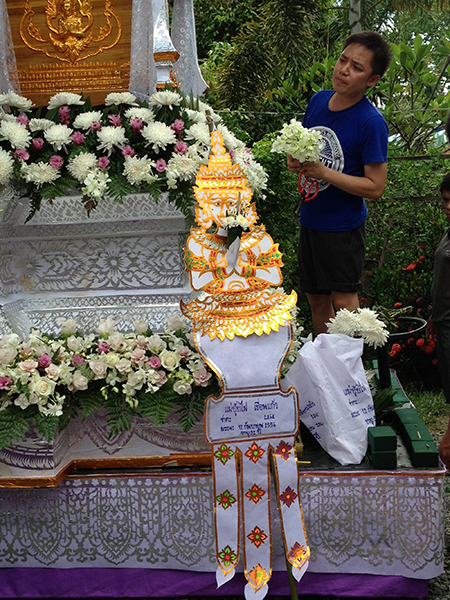
The embellishment on a three-tail banner is often minimal (fig. 8). Those bought in the marketplace are often undecorated and can be hung without the personal information of the deceased written on their surface. While it seems that the name would be an important way to increase the bond between the deceased and the banner, it does not seem to be a required component. This reflects either changes in contemporary Thai society or the differences in local variations of the tradition. Yet each three-tail banner, regardless of its degree of elaboration, has the specific intention of visually connecting it to the deceased and is used during the funeral to guide the spirit on its path.
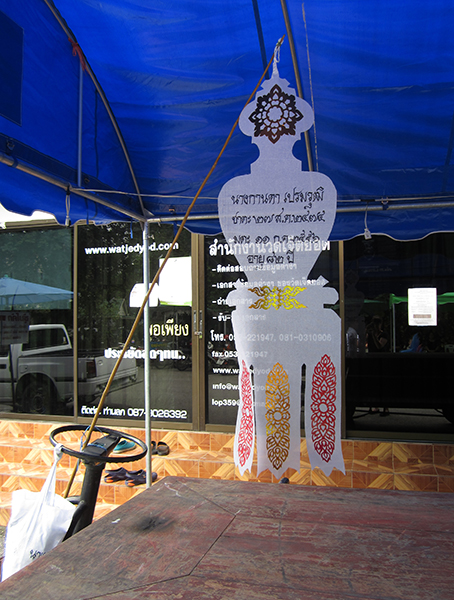
The Role of the Three-tail Banner in the Funeral Ceremony
Once the three-tail banner has been made and/or purchased, it is taken either to the home of the deceased or to the wat (monastery) and hung at the head of the corpse during the entire funeral.[23] From that time until the cremation, the banner remains next to the corpse. The explicit connection between the single, specific banner and the deceased is made even clearer when the maker inscribes the banner with the deceased’s personal information, specifically his name and birth and death dates. This association is integral for explaining the role of the three-tail banner in the funeral ceremony.
The time between death and cremation is volatile, with a heightened risk for a spirit to wander and lose its way, stay around a village or neighborhood, and wreak havoc as a ghost. Thus, the three-tail banner fulfills the important role of guiding the spirit of the deceased from one location to another and then on a path to heaven. In interviews with the author, monks and laity in and around Chiang Mai usually cited this function as a spirit guide as the reason for the three-tail banner’s steadfast presence at Northern Thai funerals.[24] The close connection between the banner and the spirit of the dead is noteworthy. Some suggest that this link explains why the three-tail banner is so visually present: it serves as a warning that those not participating in the funeral should take caution. Often clothes are removed from clothing lines, children are rushed inside houses, and windows are closed before a funeral procession passes by—a way to further protect those who are not involved with the funeral from potentially wandering spirits.[25]
At no point in the funeral ceremony is the banner’s purpose as a guide for the dead clearer than in the procession to the cremation ground. A funeral procession might travel a sizeable distance, and the spirit must not be tempted to stray. During this time, the three-tail banner and the person who carries it are most vital. The banner is carried at the front of the procession, usually with the white bag that holds provisions for the journey of the dead as he travels to heaven. The person selected to carry the banner is always male, but other deciding factors vary from one village to another. For example, in parts of the San Pa Tong district of Chiang Mai province, the person who carries the banner is of low standing in the village, often the undertaker or perhaps a drunk or a resident with mental disabilities.[26] Carrying the banner is a perilous responsibility because of its association with the spirit of the dead and the potential for the spirit to possess the banner carrier.
Once the procession arrives at the cremation ground, several concluding ceremonies take place; the most important is the offering of robes to the monks. Following this, the corpse is prepared for cremation by the undertaker, who opens the coffin to wash the corpse with water from a freshly opened coconut. The three-tail banner then is placed into the coffin with the corpse. This deliberate action of placing the banner in the coffin and burning it in the cremation fire further enhances its specific connection with the deceased and the uncertainty that follows the departure of the spirit from the body.[27] The final moment comes when the fire is lit, often following a smoke and firework display that both entertains viewers and enhances the cremation experience. The fireworks also might be a way to call attention to the cremation as it takes place, scare away any spirits that have wandered, and provide a final preparation for the spirit of the deceased to make its journey, ideally to heaven.
Northern Thai Buddhists overwhelmingly focus on the goal of attaining rebirth in heaven. Several aspects of the funeral, including the three-tail banner, relate specifically to these ideals. The generic term sawan is commonly used to refer to a heaven that is full of riches and rewards for a life well lived. Visions of golden palaces, jeweled trees, beautiful music, and graceful beings are represented in Buddhist narratives and murals. These images entice many Buddhists to imagine the satisfaction of heavenly rebirth, and such a goal then inspires them to make merit with great regularity. The three-tail banner has connections to heavenly desires as well, in that it is believed to guide the spirit of the deceased to its heavenly rewards.
Equally as important and closely connected to the banner’s function of helping the deceased reach heaven is its role to communicate with the living and remind attendees about the nature of funerals and the inevitability of death. An elderly man in Chiang Mai stated in an interview, “The three-tail banner is there to remind the living that this will be you one day.”[28] His perspective puts aside more typical worries about wandering spirits and echoes the larger lessons of the Buddhist funeral, namely that the living must face the reality of death and strive to be good Buddhists throughout their lives. This man’s point of view also helps to reinforce the multivalent role of the three-tail banner as it negotiates its way between the living and the dead.
Further Connections between Banners and the Spirits of the Dead
The three-tail banner highlights the multivalent aspects of funeral objects and the adaptability of their meanings to the needs of the viewer or funeral attendee. The many interpretations offered by Northern Thais about the banner’s form are explicitly Buddhist, while explanations for its purpose within the funeral vary. While some accounts focus on the banner’s role as guide for the spirit of the dead, others explain that a three-tail banner is hung at a funeral to show that the deceased was a faithful Buddhist.[29] Together these discussions highlight the syncretic nature of Northern Thai Buddhism and the Buddhism of the region as a whole, fusing together Buddhist teachings with local “non-Buddhist” beliefs about the power of spirits. Many scholars have explored the syncretism present in Thai Buddhism and in Southeast Asia as a whole, noting the futility in attempting to separate and label different beliefs and practices.[30]
Fear of lost spirits and disruptive ghosts is common in Northern Thailand, and one important step in reassuring the populace that the dead do not remain in the area as ghosts is to follow the proper procedures in a funeral ceremony. Many different kinds of spirits and ghosts exist in Buddhist and, more specifically, Northern Thai cosmology and belief. [31] Falling under the larger category of the “supernatural,” the subcategories and kinds of spirits that make up the pantheon are quite elaborate, reflecting individual, local, and Buddhist perceptions of inexplicable phenomena.[32] The winyan (human spirit), for example, is part of the supernatural world, as are preta (hungry ghosts) and thewada. Of greatest concern are phi (malevolent spirits) that linger around haunting the living and causing all sorts of nasty afflictions; yet any number of spirits can cause problems in daily life. However, some of the most dangerous spirits are the result of sudden or violent death, such as a car accident or death during childbirth.
Ideas about spirits of the wandering dead, and more specifically about malicious spirits, are present in popular stories and movies throughout the region, reiterating and reinforcing local beliefs.[33] In fact, horror films about ghosts are some of the most popular forms of entertainment in contemporary Thailand, with many films using ghosts as a vehicle not just for entertainment, but also to indicate social, political, and sexual difference.[34] The popularity of ghost films is a reminder of the complex relationship Thais have with ghosts: entertainment on the one hand, but a continual source of danger and fear on the other.
These spirits often linger as a result of unexpected or violent deaths, or perhaps a dead person who remains too closely attached to a person or place. A properly performed funeral can prevent the deceased from becoming one of these spirits. It helps to cut emotional attachments to the deceased, freeing the spirit from his or her ties to the living. Funerals and merit-making ceremonies can be impetuses for controlling those spirits, giving them the opportunity to follow the right path. Other devices for controlling spirits include mediums, who have become increasingly popular in much of contemporary Northern Thailand. These mediums often dance themselves into a trance in order to become vehicles for spirits.[35]
Because the status of a spirit is ambiguous at best, the success of a funeral or other ritual performed to assist a spirit’s passage relies on a great deal of faith from participants and observers. The objects that are integral to the funeral ceremony, perhaps especially the three-tail banner, focus that faith and assure attendees that a proper passage has occurred. This is achieved through the objects’ materiality and presence, providing something for the funeral attendees and family members to focus on in the face of what is, for the most part, quite immaterial and abstract. In other words, the banner’s materiality mediates the belief that a funeral was successful and enables family members and friends to feel good about the conclusion of a funeral ceremony.[36]
The specific association between the three-tail banner and the spirit of the deceased and the banner’s role as a spirit guide are most likely fundamental reasons why many Northern Thais are hesitant to discuss this banner away from its funerary context. In several instances, interviewees mentioned the inauspicious nature of three-tail banners and seemed perplexed at my questions about them and their meaning. Apprehension about three-tail banners also makes some residents of Northern Thailand believe that the appearance of one at the front of a procession is a warning to send children inside their houses for extra protection against spirits.[37]
Three-tail banners are not the only banner form in Northern Thailand or the larger region associated with funerals and the deceased. The others—tung sao wa (twenty wa banners[38]) and tung daeng (red banners)—serve different purposes. An important trait that is shared between these banner types is their association with assisting the spirit of the deceased to improve rebirth and helping the deceased find their way to heaven.
Tung daeng are used only in times of bad or unnatural deaths; they can be seen hung on a pole next to a road or highway, marking the site of a fatal accident (fig. 9). The red color of the single banner alerts passersby to the death that took place in that location, and the banner often is associated with wandering spirits, because the spirit of someone who died in an unnatural death is particularly vulnerable to getting lost. The banner is erected as part of a ceremony performed to assist the spirit, and people believe it helps the spirit escape from its wanderings, either in the vicinity of the accident or in hell.[39] Tung sao wa are displayed only after a funeral ceremony has taken place.[40] The tung sao wa looks like a ladder and reaches into the sky, and its use post-funeral relates to these visual characteristics. Importantly for this study, of the banner types associated with funerals, the three-tail banner is the most visible throughout the events of the funeral and the most closely associated with the body of the deceased.
Ceremonies and rituals that look after and make merit for the dead do not end once the funeral takes place. Ashes and bones that remain after the cremation fire has ended are collected and cared for in the days that follow. Merit-making ceremonies, complete with a variety of offerings to the monks, are performed at selected periods in the days, months, and years after the funeral; all are performed as a way of making merit that is transferred to the deceased. Such merit is then used to help the spirit of the dead get to heaven or prolong their stay there.
Colorful cloth banners are one type of offering donated to monasteries for these post-funeral, merit-making ceremonies. The banners then are hung at the monastery or stored for display on special occasions, such as religious festivals. Many have inscriptions naming the person for whom the merit was made, the date, and other details. Like the tung sao wa, this type of banner often is described by Northern Thai Buddhists as a ladder to heaven. Others explain that the cloth banners pull the deceased out of hell and deliver them directly to heaven—often quite literally, as the deceased is able to grab the tail or tails of a banner and use it in this way. Some handwoven cloth banners even include images of heavenly palaces in their iconography as a further conflation of this idealized meaning.[41]
Northern Thailand is not the only place in Southeast Asia that makes a connection between cloth banners and spirits of the dead, though the three-tail banner form is especially unique. Related groups in Laos and the Shan States also have banners that are associated with funerals or ceremonies that take place after a cremation.[42] As with the Northern Thai banners, the belief that these woven pieces of cloth can help spirits get to heaven is common. Cambodian funerals have a spirit banner called tung prahleung that has many similar associations with the deceased. It hangs next to the coffin throughout the funeral and is either burned with the corpse during cremation or reserved for post-cremation rituals. Cambodians describe the spirit banner as a kind of “passport” that the dead carry with them to travel successfully after death and ideally make their way to heaven.[43]
From a comparative perspective, banners were incorporated into funeral processions in medieval Japan and, before that, in China. Japanese white funeral banners have been discussed by Karen Gerhart as having a long history, once tied to the ancestral lineage of the deceased and protection for the living.[44] These banners were carried toward the front of a funeral procession with many other ritual implements. Like the Northern Thai funeral processions, these ritual moments held great symbolic meaning related to the passage from one life to the next.[45] Though sparsely represented in published literature, it is clear that funeral banners once had great meaning across Buddhist Asia. Further research is needed on these different banner types for a better understanding of the relationship among textiles, funerals, and spirits of the dead in Asia.
Negotiating Liminality
The human need for ritual and performance as a means for moving successfully through a liminal period is well established.[46] Occasions such as funerals that put people on a threshold of change create the need for reassurance that the proper order will continue once the liminal time period ends.[47] Once they are disposed of, material objects and works of art made for such occasions communicate that the threshold has passed and that things can return to normal. These objects are more than mere supplements to the ritual conducted by monks. They are integral components of the funeral ceremony.[48] In the case of the three-tail banner, its visibility throughout the funeral and prominent place in the procession to the cremation ground cements its place as a marker of that liminality and a cue for when the potentially dangerous spirit has moved on. The three-tail banner is exceptional in its funerary function and its symbolic meaning because of its role in enacting the ideal journey of the soul after death and reflecting on the nature of impermanence and core Buddhist principles.
The association between banners and the deceased should not be overlooked, and the explicit connection between the three-tail banner and the spirit of the deceased at a funeral is an exceptional component of Northern Thai culture. The three-tailed banner’s presence at the foot of the coffin throughout the funeral cements a unique bond between the banner and the spirit of the deceased. The apprehension that most Northern Thai Buddhists have about the three-tail banner drives home this point. But the most important role that the three-tail banner has during the funeral ceremony is its procession to the cremation ground and destruction in the cremation fire. During this process, the banner is made active through its movement in space as it is being carried by the undertaker, leading the corpse and spirit to the cremation ground. It is only through this performative action that people’s worries about wandering spirits can subside and the transformation from death to a new life can take place.[49]
The requisite presence of a three-tail banner at a funeral for someone who has died an ordinary death is quite clear and reiterated in conversations about these unique art objects. The form is of great importance and is believed to relate to any variety of Buddhist teachings. But perhaps what makes the three-tail banner particularly special is its ability to negotiate the uncertain period of time surrounding a death and ease concerns of the living about their vulnerabilities during that time.
The most potent message in a Buddhist funeral is impermanence, and the most compelling and visible material objects in a Northern Thai funeral embody that message. The ephemeral nature of the three-tail banner echoes the temporary nature of the funeral ceremony from beginning to end. Just as some Buddhist objects serve as representations of doctrine, the funeral banner is more of a reminder of the syncretic nature of Northern Thai Buddhist practices, giving Buddhists a feeling of control over natural forces that can become perilous if not dealt with in the proper way.[50]
The three-tail banner is an example of a local form of cultural production that speaks to a universal truth. The banner shares its larger purpose as an object to ease fears during a period of change with many other artworks from Northern Thailand and across Buddhist Asia. Yet, rather than through static means, the three-tail banner accomplishes this through its movement with the corpse and its disappearance in the cremation ceremony.
The attention to detail and concern for precise implementation in the creation of a three-tail banner is the first step in setting into motion the correct conclusion to a person’s life and the proper initiation into the deceased’s next birth cycle. Though no specific rules regulate its production beyond its general shape, color, and producer, the three-tail banner’s embellishment is often given great care as a way of honoring the dead, adding to its symbolic meaning, and creating additional potency through beauty when time and money allow. As this essay has revealed, sometimes the most ephemeral objects carry the most meaning in a ritual context. Overlooked by researchers in the past, objects such as the three-tail banner have the potential to provide great insight into the meaning of art within religious contexts and the centrality of material things in assuring that a ceremony is successful.
Author’s Note
I would like to thank Michelle Wang and Wei-Cheng Lin for inviting me to contribute to this volume and for their comments as I progressed on this work. Appreciation must also go out to my peer reviewers for their comments and suggestions and to the countless people who have helped me gain insight into Northern Thai funeral arts, especially Niphan Chounchaisit, Praphat Ruengthanoo, Suwipa Champawan, Kenneth Dobson, and Bonnie Brereton.
Notes
Northern Thailand is a geographical region that includes the provinces of Chiang Mai, Chiang Rai, Phayao, Lamphun, Lampang, Phrae, Nan, Mae Hong Son, and Tak. These provinces have a shared past as part of the Lanna Kingdom (1292–1775/1873) and cultural practices and beliefs that are different from those in other regions of Thailand. The three-tail banner described in this essay is unique to Northern Thailand.

Alfred Gell, Art and Agency: An Anthropological Theory (Oxford: Oxford University Press, 1998), 1–7.

Konrad Kingshill, Ku Daeng—The Red Tomb: A Village Study in Northern Thailand (Chiang Mai, Thailand: The Prince Royal’s College, 1960), 158; Phra Khru Anusaranasasanakiarti and Charles F. Keyes, “Funerary rites and the Buddhist meaning of death: an interpretive text from Northern Thailand,” Journal of the Siam Society 68, no. 1 (1980), 22.

I conducted interviews at five monasteries and three cremation-structure production facilities in July 2013 and December 2015. During these interviews, the meaning of the three-tail banner was always a topic of discussion.

Taking refuge in the Triple Gem is one of the most common actions in Buddhist practice. Doing so identifies one as a Buddhist. This action can be performed by laity and monks at any number of ritual occasions. When taking refuge in the Triple Gem, the devotee makes a formal declaration about seeking protection, stating something like “I go to the Buddha for refuge. I go to the dhamma for refuge. I go to the sangha for refuge.” Robert E. Buswell Jr. and Donald S. Lopez Jr., The Princeton Dictionary of Buddhism (Princeton and Oxford: Princeton University Press, 2014), 704.

The interviews took place at Wat Koh Klang, Wat Chom Thong, and Wat Doi Saket.

Julia Cassaniti, Living Buddhism: Mind, Self and Emotion in a Thai Community (Ithaca, NY: Cornell University Press, 2015).

The funerals discussed in this essay are those performed for an ordinary death. Many different types of death can occur, and the funeral ceremony can vary as a result. For a list and discussion of these, see Anusaranasasanakiarti and Keyes, “Funerary rites and the Buddhist meaning of death,” 5.

Nancy Eberhardt, Imagining the Course of Life: Self-Transformation in a Shan Buddhist Community (Honolulu: University of Hawai‘i Press, 2006), 60.

With unusual deaths that occur as a result of an accident or another unexpected occurrence, the events and objects that are typically part of a funeral ceremony are not used. This essay focuses specifically on natural deaths and the common set of rites, objects, and actions for a typical funeral ceremony.

See Donald Swearer, The Buddhist World of Southeast Asia (Albany, NY: SUNY Press, 2010), 64–66. The Abhidhamma is one of the core texts of the Pali canon. Sections of the Abhidhamma are commonly recited at funerals in Thailand, specifically those parts dealing with anicca or impermanence.

Erik W. Davis, “Weaving Life out of Death: The Craft of the Rag Robe in Cambodian Ritual Technology,” Buddhist Funeral Cultures of Southeast Asia and China (Cambridge: Cambridge University Press, 2012), 62–63.

For a discussion of traditional Northern Thai cremation structures, see Sommai Premchit and Amphay Doré, The Lan Na Twelve-Month Traditions (Chiang Mai, Thailand: Faculty of Social Sciences, Chiang Mai University, 1992), 91–92. Mani Phayomyong, Kreuang Sakkara nai Lanna Thai (เครื่องสักการะในลล้านนาไทย, Objects of Worship in Northern Thailand) (Chiang Mai, Thailand: Thanakhan Thai, 2006), 116–17. The practice of housing the corpse in a cremation structure is changing in contemporary Northern Thailand as a result of increased wealth, influence from Bangkok, and concerns about air pollution.

For more discussion of the most elite cremation structure, see Rebecca Hall, “Onward Toward Heaven: Burning the Nok Hatsadiling,” Ars Orientalis 44 (2014), 181–99.

White cotton string (called sai sin in Thai) is commonly used in many different Buddhist and non-Buddhist ceremonies in Northern Thailand and throughout most of Buddhist Southeast Asia. The string is often held by monks or attached to a Buddha image during ceremonies, as it is during a funeral. It is believed to hold sacred and protective power.

Premchit and Doré, The Lan Na Twelve-Month Traditions, 100; Vithi Phanichpant, Withi Lanna (วิถีลานนา, Lanna Culture) (Chiang Mai, Thailand: Silkworm Books, 2005), 147.

In several interviews in Chiang Mai province in December 2014, I inquired about the possibility of making a three-tail banner myself or even just adding my own decorations to embellish the surface (with the obvious factor that I am female). I was told emphatically that I could not do such a thing and that making a funeral banner would bring me terrible luck, including dangerous accidents or illness.

The process of cutting a three-tail banner was demonstrated to me in Chiang Mai province, January 2015. Also see Benjaphol Sittipranit, Tung (ตุง, Banners) (Chiang Mai, Thailand: Nopburee, 2006), 43–44.

Interview with the abbot of Wat Tha Pong, San Pa Tong district, Chiang Mai province, December 2014. Unfortunately, he did not explain how the banners would have looked different.

I visited Khun Niphan’s shop twice in July 2013 and interviewed Khun Niphan on both visits.

The Chulamani stupa holds the first Buddhist relic (the hair that the Buddha cut off after leaving the palace) and is believed to be one of the most important sites in Thai Buddhism. Because the stupa is located in Indra’s heaven (called Tavatimsa), it provides residents of Tavatimsa and Tusita heaven with the opportunity to pay respects to the Buddha and make merit. An image of Chulamani stupa is often used as a symbol of heaven.

One of the discrepancies so far in this research is the placement of the banner. I have been told by people that it hangs at the feet of the deceased and by others that it hangs by the corpse’s head.

I conducted interviews with monks, novice monks, artists responsible for making banners and prasat, and general laity in Chiang Mai province in July 2013, December 2014, and January 2015.

Interview with the monk Phra Anont at Wat Chamathewi, Lamphun, December 2014.

The undertaker is a low-status position in Northern Thai society. He prepares the body and is a presence at the funeral from beginning to end, tending to the cremation fire and gathering the bones the following day. See www.kendobson.asia/blog/three-tailed-banners-varieties-of-faith.

While this action of setting the three-tail banner in with the corpse to burn in the cremation fire is consistently cited as an important part of the banner’s role in the ceremony, I have seen several cremations in which the banner was not burned. When I ask about it in interviews, most people state that it is always burned. One monk did suggest that if the banner does not get burned, it is because sometimes people forget. Phra Anont, Wat Chamathewi, December 2014.

Konrad Kingshill, Ku Daeng—Thirty Years Later: A Village Study in Northern Thailand 1954–1984 (Dekalb, IL: Northern Illinois University, Center for Southeast Asian Studies, 1991), 162.

See S. J. Tambiah, Buddhism and the Spirit Cults in North-east Thailand (Cambridge, UK: Cambridge University Press, 1970); Barend Jan Terweil, Monks and Magic: Revisiting a Classic Study of Religious Ceremonies in Thailand (Copenhagen: NIAS Press, 2012); Pattana Kitiarsa, “Beyond Syncretism: Hybridization of Popular Religion in Contemporary Thailand,” Journal of Southeast Asian Studies 36, no. 3 (2005), 461–87; Justin Thomas McDaniel, The Lovelorn Ghost and the Magical Monk: Practicing Buddhism in Modern Thailand (New York: Columbia University Press, 2011).

See Tambiah, Buddhism and the Spirit Cults, 57–61, and Andrew Alan Johnson, Ghosts of the New City: Spirits, Urbanity, and the Ruins of Progress in Chiang Mai (Honolulu: University of Hawai‘i Press, 2014) for elaboration on these forms. For a discussion of beliefs about these spirits, see Julia Cassaniti and Tanya Marie Luhrmann, “Encountering the Supernatural: A Phenomenological Account of Mind,” Religion and Society: Advances in Research 2 (2011), 37–53.

Julia Cassaniti, “Intersubjective Affect and Embodied Emotion: Feeling the Thai Supernatural,” Anthropology of Consciousness 26, no. 2 (September 2015).

See McDaniel, The Lovelorn Ghost, 92–99; Katarzyna Ancuta, “Global Spectrologies: Contemporary Thai Horror Films and the Globalization of the Supernatural,” Horror Studies 2, no. 1 (2011), 131–44.

Arnika Furmann, “Nang Nak—Ghost Wife: Desire, Embodiment, and Buddhist Melancholia in a Contemporary Thai Ghost Film,” Discourse 31, no. 3 (fall 2009), 220–47.

See Rosalind C. Morris, In the Place of Origins: Modernity and Its Meditations in Northern Thailand (Durham, NC: Duke University Press, 2000); Johnson, Ghosts of the New City.

David Morgan, Religion and Material Culture: The Matter of Belief (London and New York: Routledge, 2010), 11–12.

Chamaiphon Phonphenphiphat, Tung: Moradok Phaendin Lanna (ตุงมรดกแผ่นดินล้านนา, Banners in the Heritage of Northern Thailand), 139.

The wa is a Thai unit of measurement equivalent to the length of outstretched arms or about 1.5 meters.

The Tai Yai or Shan of Mae Hong Song province have a very similar ceremony and banner type to help victims of unnatural deaths. For a detailed account, see Eberhardt, Imagining the Course of Life, 60–67.

Rebecca Hall, “Materiality and Death: Visual Arts and Northern Thai Funerals,” Journal of Southeast Asian Studies 46, no. 3 (fall 2015), 363–65.

I learned about the tung prahleung while conducting fieldwork on Cambodian banners in 2008. The discussion of these spirit banners as passports came up frequently in interviews. See also Ang Choulean, Brah Ling (Phnom Penh: Reyum Publishing, 2004), 127–41.

Karen M. Gerhart, The Material Culture of Death in Medieval Japan (Honolulu, University of Hawai‘i Press, 2009), 121–22; 205, no. 25.

Victor Tuner’s work has been foundational for our understanding of liminality and the role that ritual plays in helping people to navigate transitional moments. After Turner, the study of liminality has expanded beyond ritual and performance to include a variety of fields, including health care, economics, and political science. See, for example, Victor Turner, The Ritual Process Structure and Anti-Structure (Ithaca, NY: Cornell University Press, 1969).

Victor Turner, “Liminality and Communitas,” The Performance Studies Reader, ed. Henry Bial (London and New York: Routledge, 2007), 89–90.

While the three-tail banner is unique in form and use, other Southeast Asian cultures have funeral banners that perform similar duties. Perhaps the most similar that I am aware of is the spirit banner, or tung prahleung, used in funerals in Cambodia.

Fabio Rambelli, Buddhist Materiality: A Cultural History of Objects in Japanese Buddhism (Stanford, CA: Stanford University Press, 2007), 259.

Ars Orientalis Volume 46
Permalink: https://doi.org/10.3998/ars.13441566.0046.003
For more information, read Michigan Publishing's access and usage policy.

